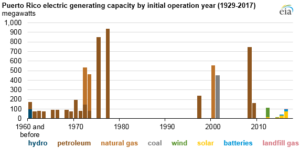It has been almost a year since Hurricanes Irma and Maria hit Puerto Rico. The hurricanes destroyed much of Puerto Rico’s already-ailing electric infrastructure, causing widespread blackouts lasting months. And, while Puerto Rico’s power plants that use coal, oil, and natural gas are now operating at nearly 100 percent, most onshore wind power plants, representing 76 percent of the island’s total wind energy, are currently not operating, nor is 32 percent of the island’s solar energy farms. Of the battery facilities that were added to the island in 2015 and 2016, one facility, representing 12 percent of the island’s battery capacity, is not operational. While most of the wind and solar units are expected to be operational by the end of this calendar year, one wind and one solar plant reported to the Energy Information Administration that they would not return to service this year.
Puerto Rico’s Generating Capacity
The oldest power plants operating in Puerto Rico are hydroelectric plants, almost all built before 1960. Between 1960 and 2009, Puerto Rico added fossil fuel plants that were mainly powered by petroleum. The territory’s first natural gas plant came online in 1972, and a coal plant in 2001. After 2009, Puerto Rico added solar photovoltaic, onshore wind, and landfill gas technologies followed by a small number of utility-scale batteries. The territory is expected to add a few solar photovoltaic and landfill gas plants with a combined capacity of 32.4 megawatts in 2018.

Almost 80 percent of Puerto Rico’s electricity generating capacity is owned by the Puerto Rico Electric Power Authority (PREPA), which filed for bankruptcy in July 2017—two months before the hurricanes hit the territory. In January 2018, Puerto Rico’s governor announced that all PREPA assets would be privatized.
Puerto Rico’s coal-fired generating plant is located at Guayama. The 454-megawatt plant uses circulating fluidized bed combustion and consumes about 1.6 million short tons of coal annually, imported from Colombia. The plant was damaged by Hurricane Maria in September 2017, and resumed generating power in February 2018.
Puerto Rico imports natural gas from Trinidad and Tobago, which is received at the Peñuelas terminal and regasification facility at Guayanilla Bay on the southwestern coast. The liquefied natural gas facility was built to supply the 507-megawatt EcoEléctrica electricity generating plant, which is adjacent to it. In 2012, PREPA converted a nearby oil-fired generating station to dual-fuel capability with natural gas.
Puerto Rico has the largest wind and solar farms in the Caribbean. In fiscal year 2016 to 2017, about 2.4 percent of PREPA’s electricity came from renewable energy sources, with wind and solar each supplying two-fifths. The rest came from hydroelectric and landfill gas facilities. Two renewable facilities on Puerto Rico’s east coast were badly damaged by the hurricanes: Puerto Rico’s second largest solar farm at Humacao, which had begun generation in December 2016, and the second largest wind farm at Naguabo.
Solar power has been Puerto Rico’s fastest growing renewable resource. In June 2017, three-fourths of Puerto Rico’s solar generation came from utility-scale facilities and one-fourth from distributed solar panels. The largest solar farm, the Oriana facility at Isabela, has 45 megawatts of capacity and came into service in late 2016, as did the first 20 megawatts of a 40-megawatt solar facility at Humacao. As of June 2017, Puerto Rico had 5 utility-scale solar farms in full operation, 1 partially commercial and partially preoperational, and another in preoperational testing, plus 14 more solar projects in negotiations with PREPA. In addition, over 8,500 customers with almost 88 megawatts of distributed capacity were connected to the grid by net metering.
Puerto Rico has two utility-scale wind farms: the 23-megawatt facility at Naguabo and the first phase of the 101-megawatt facility at Santa Isabel, both of which began service in 2012. Puerto Rico’s offshore wind resource is limited; the sea is generally not shallow enough to accommodate wind turbines.
Puerto Rico has 21 hydroelectric generating units, which were built beginning in 1915. In the last four years, they have supplied about one-sixth of Puerto Rico’s renewable electricity. Two generators using landfill gas are located at Fajardo and Toa Baja. Fajardo began generating electricity in late 2015 and is in commercial operation. Toa Baja is still in startup. Biomass produced 3 percent of Puerto Rico’s renewable electricity.
In 2010, Puerto Rico’s legislature enacted a renewable portfolio standard that required PREPA to obtain 12 percent of its electricity from renewable sources beginning in 2015, scaling up to 15 percent by 2020 and 20 percent by 2035. The 2015 goal was not met. From 2008 to 2012, PREPA signed 68 long-term power purchase agreements with solar, wind, and biomass energy developers for about 1,600 megawatts of renewable capacity. Of those, only 11 contracted projects have been built, 10 were canceled, and 47 contracts are inactive or in renegotiation. In 2014, PREPA renegotiated some contracts to require energy storage equal to 30 percent of project capacity to increase grid stability. Three of Puerto Rico’s five solar farms incorporate batteries that are charged during daylight hours, supplying the grid overnight.
Conclusion
Puerto Rico is slowly restoring its electric grid and generating capacity after Hurricanes Irma and Maria devastated the territory in September 2017. Puerto Rico’s fossil fuel generating capacity is now operational, but most of its wind and solar capacity is not, and may not be operational until 2019.



